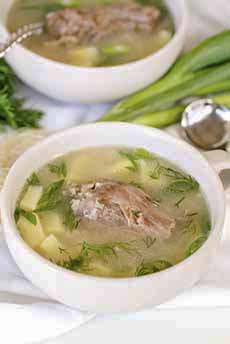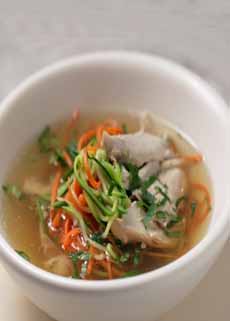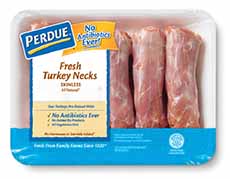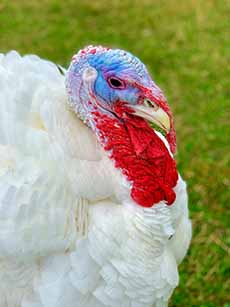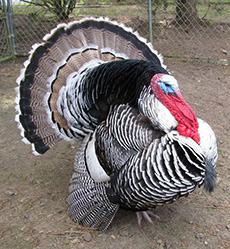Turkey Neck Soup Recipe & The History Of Turkeys (& The Soup)
|
|
THE NIBBLE first created its Daily Food Holiday Calendar in 2004. But it’s taken us this long to address one of the more unusual holidays: National Turkey Neck Soup Day, March 30th. Turkey neck soup is a concept we’d only come across on the calendar. This year, for the first time, we had enough down time to wonder: Who established a holiday for turkey neck soup? And do you need more than one turkey neck? We couldn’t find an answer to who, but it turns out that turkey neck soup is a more economical way to feed a family than, say chicken or turkey soup made with the main parts of the poultry. And yes, you do need more than one turkey neck. Some people freeze the necks from the giblets bags that come in whole turkeys and chickens, until they have enough. You can buy turkey necks in the poultry department of supermarkets from Perdue and Shady Brook Farms, along with non-branded packages. Turkey necks themselves are bony, but they do have meat; and thus can be used to make that Paleo diet darling, bone broth. > A brief history of turkey is below. > The history of soup and the different types of soup. The first turkey neck soup was made somewhere in what is now Mexico and the eastern and southwestern U.S., where the wild turkey originated (photos #4 and #5). Like many ingredients in soups and stews, turkey neck soup likely evolved as a practical way to use all parts of the turkey, including the neck, which isn’t as easy to eat otherwise*. Turkey neck soup is still common in various cultures and cuisines where turkey is eaten, including American Southern cooking, where it’s often cooked like chicken soup, seasoned with herbs and vegetables. See other preparations in the footnote† below. Similar soups elsewhere around the world, where poultry necks are valued for both their rich flavor and collagen content. Today the soup represents a traditional form of nose-to-tail cooking that predates modern food waste concerns, focusing on using every part of the animal. Wild turkeys (Meleagris gallopavo) have been around for millions of years. Fossil evidence suggests that their ancestors appeared in North America around 5 million years ago, during the Miocene epoch. The modern wild turkey species likely evolved around 2.5 million years ago, during the Pleistocene epoch. Turkeys are part of the Phasianidae family, which includes pheasants, quail, and chickens,. They share a common ancestor with other game birds that date back even further. (Ducks belong to a different family, Anatidae, which includes geese and swans‡.) Indigenous peoples in the Americas domesticated turkeys over 2,000 years ago, long before European contact. Archaeological evidence suggests that Native Americans domesticated turkeys as early as 200 B.C.E. to 500 C.E., particularly in central Mexico and the southwestern U.S. (Turkeys were one of the few animals domesticated by pre-Columbian Mesoamerican peoples, bred turkeys for both for their meat and feathers.) The birds found their way to the East Coast, with the gratitude of the Pilgrims for whom they were a critical food source. There are two main species of turkey: And the original name for the bird? The Aztec (Nahuatl) name for turkey is huexolotl or uexolotl (pronounced way-SHO-lotl). The linguistic root of huexolotl still exists in modern Mexican Spanish, where the word for turkey is “guajolote.” [Source: Claude.ai 2025-03-30] |
|
|
________________ *Turkey necks, while most commonly used in soup in the U.S., are also braised/roasted, smothered in gravy, grilled, smoked, even deep-fried. †There are also heritage breeds such as the Black Spanish, Bourbon Red, Narragansett (photo #7), Royal Palm, and Standard Bronze; but these are less common in supermarkets and typically obtained from butchers. See them here. ††A heritage breed is a traditional livestock breed that was developed over time through natural selection and selective breeding, often before the rise of industrialized agriculture. These breeds are typically genetically diverse, hardy, and well-adapted to specific environments or traditional farming methods. For turkeys, this means natural mating (no artificial insemination) and slow growth (6-7 months to reach market weight compared to 3–4 months for commercial breeds like the Broad Breasted White). ‡The distant common ancestor of both chickens (Phasianidae family) and ducks (Anatidae family) was likely a primitive Galliformes-Anseriformes bird that lived some 60–90 million years ago during the Late Cretaceous or early Paleogene period. Both chickens and ducks belong to the order Galloanserae, a major bird clade that includes Galliformes (landfowl like chickens, turkeys, and quail) and Anseriformes (waterfowl like ducks, geese, and swans). A clade is a group of organisms that includes a common ancestor and all of its descendants. It represents a single branch on the tree of life. |
||
